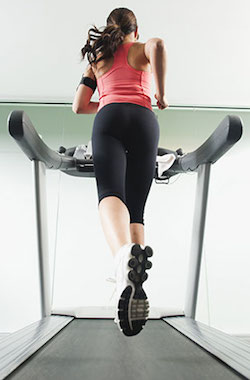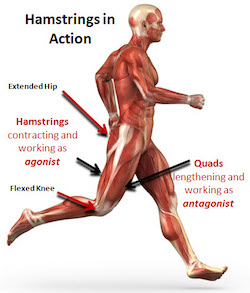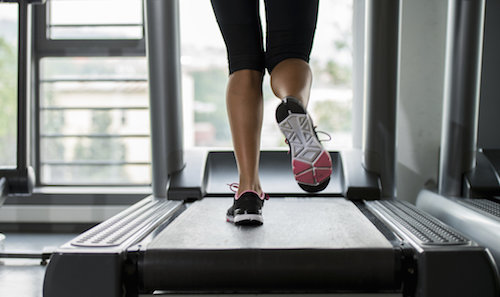 The real benefit of standing desks is that they allow you to move more. We’ve covered that before. We’ve also said that blood flow is incredibly important, and that humans are designed to have healthy blood flow only when our calves flex regularly, as they do when walking.
The real benefit of standing desks is that they allow you to move more. We’ve covered that before. We’ve also said that blood flow is incredibly important, and that humans are designed to have healthy blood flow only when our calves flex regularly, as they do when walking.
So it seems like a no-brainer that treadmill desks are a great solution.
What better way to move more and flex your calves regularly than walking at your desk? Unfortunately, common sense doesn’t win out this time.
Treadmill desks are actually a pretty bad idea, because they teach bad movement patterns and hurt your productivity. Let’s dive in to the details.
Treadmill Desks are Bad Walking Practice
Walking is good. You can walk on treadmills. So treadmills must be good, right? Wrong.
Treadmill Desks Reduce Posterior Chain Engagement
When walking outside, you move relative to the ground. As we all know, the treadmill flips the script; the ground moves relative to you. It turns out this actually changes how your muscles are used.
 In typical walking stride, you engage your hamstrings and glutes to push yourself forward by pulling your legs back. In the science of gait analysis, this portion of the movement is called “the swing”.
In typical walking stride, you engage your hamstrings and glutes to push yourself forward by pulling your legs back. In the science of gait analysis, this portion of the movement is called “the swing”.
On a treadmill, the moving belt does that work for you. You just have to get your next foot out in front of you to keep from falling down, and lift your back foot to keep from moving backwards. Research shows that posterior chain engagement in “the swing” is lessened by treadmills.
For the same reason, you also miss out on some of the calf flexing that walking is supposed to provide, which was the biggest benefit we were looking for.
Losing the engagement of these three groups in your posterior chain means that treadmill walking isn’t providing the same benefit that real walking does. Even worse, walking on a treadmill trains your body to limit posterior chain engagement, hurting your walking form when you do get outdoors for the real thing.
Treadmill Desks are Dangerously Repetitive
Treadmills are flat and boring. Nature is not flat and boring. Humans aren’t meant to walk flat and boring. I’m sure this paragraph is getting flat and boring with repetition, but this is an important point.

Pictured: Poor form on flat, boring treadmill.
Walking on treadmills is the junk food of walking. [h/t Katy Bowman]
Real walking takes place over varied terrain, loading your joints and balancing muscles myriad ways as you navigate the land. Humans are built to climb mountains and jump streams, balancing direction changes from rock to rock. That’s VERY different from a flat, boring treadmill.
All of this – failing to correctly engage your posterior chain, training yourself to walk with poor form on consistently flat ground – is a recipe for injury.
Standing still doesn’t provide healthy movement, but at least it doesn’t make your walking worse. Walking on a treadmill is bad practice for walking because it actively teaches you to walk the wrong way, unevenly building and atrophying competing muscles along the way.
This means when you finally do get out of the office and into the wild, you’re very likely to hurt yourself.
But working at a treadmill desk actually hurts your work too.
Treadmill Desks Hurt Productivity
This bit of common sense is best illustrated in an anecdote from Thinking, Fast and Slow by Daniel Kahneman:
“While walking comfortably with a friend, ask him to compute 23×78 in his head, and to do so immediately. He will almost certainly stop in his tracks.”
You’ve probably experienced this. I know I have. Kahneman goes on to explain that this happens because walking represents a cognitive load (your brain is using some “CPU” to walk), and that process must be stopped to free up “CPU” for hard thinking. This is confirmed in the research.
Of course, on a treadmill, one doesn’t simply stop walking (without an ensuing faceplant, anyway). So you’ll keep walking, and your brain will run slower because of the cognitive load of walking.
Treadmill Desks are Bad Ergonomics
Let’s sum it up:
- Treadmill desks do not achieve desired posterior chain engagement.
- Treadmill desks train poor walking form.
- Treadmill desks do not offer sufficiently varied terrain for proper health and safety.
- Treadmill desks make you less productive.
I’ll add that you’ll probably have to shell out $1,000+ for a decent treadmill desk. Looks like a pretty bad deal, doesn’t it?
The Treadmill Desk Alternative
Start with a standing desk (this table should help you choose one). Be conscious of your standing surface. You want some cushioning (like an anti-fatigue mat) and some stuff around to drive movement.
Flat and boring still isn’t great when you’re standing still, so get a foot prop stool or some other “toys” around your feet to stand on and play with. This will encourage plenty of healthy movement and posture variation. We put together a video of a few common recommendations:
Do you have anything interesting under your desk to play with? What has worked for you? Let us know in the comments.





[…] for highly verbal tasks (preferably not on a treadmill), like phone […]
[…] This article suggests that when you really need to think, you stop walking (who else is old enough to remember Gerald Ford and that joke about him not being able to chew gum and walk at the same time?). Personally, I think this is ridiculous, but perhaps it depends on the individual. I’ve lost count of the times I’ve taken the dogs out deliberately to mull a few problems over and come up with solutions. […]
The difference in your case is that you’re engaging in creative thinking during those long walks, not cognitive thinking. It’s basically like daydreaming. We can daydream sitting, standing, walking, running, driving, because it doesn’t involve cognitive thought. When it’s time to task the brain with active problem solving, it’s a different story.
Is the author trying to sell an alternative to treadmill desks? These criticisms are very poor and obviously one-sided. The first two are written as if one was choosing between walking outdoors versus on a treadmill. That’s utterly missing the point. I walk many miles a day on my treadmill desk, but I still go for outdoors walks because they are different! We know that already, thank you. The author is correct that it can be difficult to do hard thinking while walking fast, which is why I STOP when I need to do so. The actual hard thinking is 15-30 minutes of my day if I’m lucky., the rest of the time I’m walking and loving it!
Hey Brian,
Thanks for your comment. The point is not that walking outdoors is better than treadmill walking. The point is that walking outdoors improves you, and walking on a treadmill makes you worse.
Hence the phrase “walking on treadmills is the junk food of walking”, which we
stole fromattribute to Katy Bowman. McDonald’s isn’t just worse than steak – it’s actively bad for you. And it’s our stance that treadmills are actively bad for you.I’ve always suspected this. Just the mere fact that you are trying to hold your upper body stationary while your lower body is moving goes against what I call “natural movement” and has always caused me low back pain and stiffness – no matter how slow I walked. While attempting to work at my walking desk I always felt the need to “fight the slouch”. If the keyboard is to low, I slouch while moving (this has to be bad) and if too high, I have to raise my shoulders in a very unnatural way – while arching my back – keeping the upper body stationary / and arms stationary WHILE the lower body is moving / resulting in everything feeling very tense and unnatural with an uncreased in sway back. I really don’t think walking on a treadmill (without working) is bad if you watch your body mechanics, don’t go too fast and swing your arms normally, but the standing working thing – just doesn’t work for me or anyone I know.
Just for the record, even if NOT slouching or over arching the back (the posture itself is correct) – the mere fact the your upper body is held stationary while the lower body moves is still the major problem when body mechanics are considered here.
So, i’m a programmer. And like a lot of programmers, i normally sit at my desk for basically 8 hours straight. What im wondering is whether using a treadmill desk for a few hours a day while doing work (i took my laptop to the gym, and walked there, doing work, and its not really less productive, because typing speed isnt whats at play – its thinking, and writing some code, and thinking, etc.) is better than just sitting for 8 hours, and not doing any exercise. This is the situation most people i know are in.
So, even if ergonomically whats ideal is going out and walking running or whatever on real environments, thats not the situation a lot of people face. We only want to know whether its better than no exercise, and sitting in the chair typing.
From my experiments, i found its a lot easier to use a treadmill and do work, then to use a standing desk and do work. When i use a standing desk, my muscles get tense and sore, and while i should probably stretch them out often, i dont, and most people i know dont either.